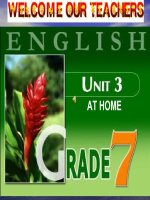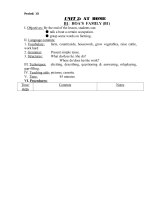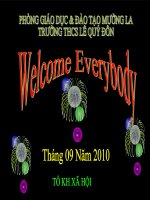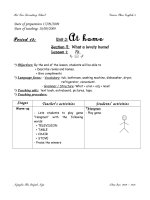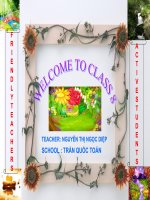Unit 3 At home
Bạn đang xem bản rút gọn của tài liệu. Xem và tải ngay bản đầy đủ của tài liệu tại đây (543.99 KB, 28 trang )
<span class='text_page_counter'>(1)</span>Date of teaching: 05-09/9/2016 Class: 8A5, 8A7 Week: 4 PERIOD: 12 UNIT 3: AT HOME Lesson 1:. Getting started & Listen and Read. (p.p. 27+28). I. OBJECTIVES: 1. Knowledge: a. Grammar: - Reflexive pronouns - Modal verb: have to, must b. Vocabulary: Wash dishes/ Make the bed/ Sweep the floor/ Cook/ Tidy up/ Feed the chicken 2. Skills: Listening – Reading 3. Attitude: By the end of the lesson, a. Sts will know how to use the modals. b. Sts will do the housework themselves. II. PREPARATION: 1. Teacher: - Prepare lesson carefully: (teaching aids, make lesson plan by power point, book, laptop, sound…) 2. Students: - Learn previous lesson by heart. - Prepare new lesson at home - Textbook, chalk III. STEPS FOR TEACHING: 1. Check previous lesson: (5’) write new words. 2. New lesson: (40’) Stage. Steps/Activities Kim’s game - T shows 6 pictures (getting started) to Sts.. Warm up (5’). - T asks Sts to look at 6 pictures quickly in 30 seconds and try to remember the verbs in the pictures as many as possible. Answers: a. Wash dishes / do the washing up b. Make the bed. Work Arrangement Whole class.
<span class='text_page_counter'>(2)</span> c. d. e. f. Presentation (10’). Sweep the floor. Cook Tidy up Feed the chicken. - The group remembering more verbs is the winner.. Group work. - T uses techniques to introduce the new words. Vocabulary: o cupboard (n): o steamer (n): o saucepan (n): o chore (n): o sink (n): o frying pan (n): o rice cooker (n): o stove (n): o give my love to:. Whole class. Checking:. What and where. - T writes the words on the board. Each word is in a circle.. Whole class. - T gets Sts to repeat the words and then rob out one of the words but do not rub out the circle. - T gets Sts to repeat the words including the rubbed out word by pointing at the empty circle. - T continues until the entire circles are empty. - T asks Sts to go to the board and fill in the circles with the correct words. - T sets the scene of the dialogue between Nam and his mother Mrs. Vui. - T gets the Sts to listen to the dialogue while looking at their books. - T asks Sts to complete the list of the things Nam has to do.. Individually. - cook dinner. Nam has to. Structure:. - go to the market to buy fish and vegetables. - call his Aunt Ms. Chi and ask her to meet his mother at grandma’s house.. Whole class.
<span class='text_page_counter'>(3)</span> Has / have to Must. + infinitive + infinitive. Meaning: phải làm gì - Must: diễn tả sự bắt buộc hay sự cần thiết có tính chủ quan, do cảm nghĩ của người nói. Ex: He must do this exercise again. - Have to: diễn tả sự bắt buộc hay sự cần thiết có tính khách quan, do yếu tố bên ngoài.. Whole class. Ex: Your eyes are weak. You have to wear glasses. - T asks Sts to practice the new structure using picture cues drill in “getting started” by asking and answering the question. Example for exchange. Pair work. What do you have to do? I must do the washing up. Practice (10’). Cues: a. b. c. d. e.. do the washing up make the bed sweep the floor cook dinner tidy my room. Pair work. f. feed the chicken Production (10’). - T gives Sts 7 words. Feed - empty – do – tidy – sweep – clean-dust. - T asks Sts to look at the pictures and complete the dialogue between Nga and Lan, using must or have to together with the verbs given. Answer: Nga: Can you come to the movies, Lan? Lan: No. I have to do my chores. Nga: What do you have to do? Lan: I must tidy my bedroom. Then I have to dust the living room and I must sweep the kitchen floor, too. Nga: That won’t take long. What else’s? Lan: I have to clean the fish tank and then I must empty the garbage. Finally, I must feed the dog.. Individually.
<span class='text_page_counter'>(4)</span> Nga: Ok. Let’s start. Then we can go out - T asks Sts to work in pairs, practicing the dialogue.. Pair work. - T asks Sts to write the things you have to do on days. Consolidation (3’). - Sts make up a new dialogue about the chores they have to do at home, using Modals.. Whole class. - T reminds the chores, how to use Modals: have to, must. Homework (2’). - Practice reading the dialogue again. - Prepare Unit 3 At home “SPEAK”.. DRAWING EXPERIENCE _________________________________________________________ _________________________________________________________ _________________________________________________________ Date of teaching: 12-16/9/2016 Class: 8A5, 8A7 Week: 5 Period: 13 UNIT 3: AT HOME Lesson 2:. Section: SPEAK 1-2. (p.p. 28+29). I. OBJECTIVES: 1. Knowledge: a. Grammar: Reflexive Pronouns. Modal verbs: Must, have to, ought to. b. Vocabulary: refrigerator, plate, bowl, counter, disk rack, coffee table, rug, cushion… 2. Skills: Speaking 3. Attitude: By the end of the lesson, a. Sts will be able to use the prepositions of place to talk about the positions of furniture in the house. b. Sts will arrange and design the house by their ways. II. PREPARATION: 1. Teacher: - Prepare lesson carefully: (teaching aids, make lesson plan by power point, book, laptop, sound) 2. Students: - Learn previous lesson by heart..
<span class='text_page_counter'>(5)</span> - Prepare new lesson at home: (write new words; read text; translate the text into Vietnamese; answer questions) III. STEPS FOR TEACHING: 1. Check old lesson: (5’) Write sentences with “be going to”, using the words or phrases given. 8A5 1. My children/ spend/ their vacation/ a farm. ................................................................................................................ 2. My mother/ prepare/ food/ my birthday party/ next week. ................................................................................................................. 8A7 3. Hoa/ see/ her parents/ the country. ................................................................................................................. 4. They/ have/ an important test/ Friday. ................................................................................................................. 2. New lesson: (40’) Stage. Steps/Activities - T divides the class into 2 groups.. Work Arrangement Group work. - T shows the picture of a kitchen to Sts. Warm up (5’). - T asks them to study the things in the picture. - T takes away the picture and asks Sts to write down as many things as they can remember. - The group having more things wins the games. Vocabulary: refrigerator (n): plate (n):. Group work Whole class. bowl (n): counter (n): Pre-Speaking (10’). disk rack (n): coffee table (n): rug (n): cushion (n): Set the scene: "Mrs. Vui bought new practice furniture for. Individually. her living room, but she cannot decide where to put it. You should help her to arrange the furniture." - T asks Ss to look at the picture and talk about their ideas. While-Speaking - T asks Sts the positions of the items in the pictures.. Individually.
<span class='text_page_counter'>(6)</span> Where is the clock? Where is the fruit?. It's above the fridge. It’s in the bowl.. Where are the flowers? They are on the table. Where is rice cooker?. It’s next to the bowl of fruit.. Where is cupboard?. It’s on the wall, above the counter.. Where are knives?. They’re on the wall, under the cupboard.. Where is dish rack?. It’s on the counter, next to the bowl of fruit.. (10’). Pair work. - T gets Sts to work in pairs, talking about the position of each item. Ex: - The calendar is on the wall, under the clock and above the refrigeration - The sink is next to the stove - The cupboard is on the wall, above the counter - The knives are on the wall, under the cupboard - The bowl of fruit is between the rice cooker and the disk. Pair work. rack - The flowers are on the table.. Post-Speaking (10’). - T sets the scene: “Mrs. Vui bought new furniture for her living room, but she cannot decide where to put it. You should help her to arrange the furniture.”. Whole class. - T asks Sts to look at the picture and talk about their ideas. E.x:. Individually. - Let’s put the clock on the wall, between the shelf and the picture. - Ok. I think we ought to put the TV and the stereo on the shelf. - I think the coffee table should be between the couch and the armchair. - Let’s put the telephone next to the couch..
<span class='text_page_counter'>(7)</span> - I think we should put the magazines above the books on the shelves.. Group work. - I think the shelves ought to be at one of the corners, opposite the couch. - T asks Sts to practice speaking. Suggested for agreement and disagreement: Pair work. - Agreement: Ok / you are right. - Disagreement: + No, I think we’d better/ ought to put… + I think it should be……… - Describe your living room / bedroom. Some say in front of class Homework. Write a paragraph about 50 words to describe their bedroom - Practice talking about positions of things around. - Prepare Unit 3 LISTEN. DRAWING EXPERIENCE _________________________________________________________ _________________________________________________________ _________________________________________________________. Date of teaching: 12-16/9/2016 Class: 8A5, 8A7 Week: 5 Period: 14 UNIT 3: AT HOME Lesson 3: I. OBJECTIVES:. Section: LISTEN. (p.30). Individually.
<span class='text_page_counter'>(8)</span> 1. Knowledge: - Developing listening skill. a. Grammar: Reflexive Pronouns Modal verbs: Must, have to, ought to b. Vocabulary: words describing house and home preposition of place. 2. Skills: Listening 3. Attitude: By the end of the lesson, a. Sts will be able to identify the right item by listening and further practice in modal verb: ought to. b. Sts will try to cook meals themselves. II. PREPARATION: 1. Teacher: - Prepare lesson carefully: (teaching aids, make lesson plan by power point, book, laptop, sound) 2. Students: - Learn previous lesson by heart. - Prepare new lesson at home: (write new words; read text; translate the text into Vietnamese; answer questions) III. STEPS FOR TEACHING: 1. Check old lesson: (5’) Look at the picture and answer the questions: 8A5 1. Where’s the sink? 2. Where’s the refrigerator? 8A7 3. Where’s the dish rack? 4. Where’s the calendar? 2. New lesson: (40’) Stage. Steps/Activities - T asks Sts some questions about the food.. Work arrangement Whole class. Do you usually have breakfast before going to school? Warm up (5’). What do you often have for breakfast? Do you like to eat fried-rice? Do you know how to make this food?. Pre-Listening (10’). -T leads to the new lesson. - T says: “All right today we will learn how to cook the fried rice -The special Chinese fried rice” - T asks Sts to look at the pictures on p.30 and then match these words with the correct pictures. Matching:. Whole class.
<span class='text_page_counter'>(9)</span> - Chicken and peas - Ham and peas - A steamer - A pan - Garlic and onions - Garlic and green peppers - Fried rice - Noodles - T asks Sts to read again these words ( chorus, individually) - T points to each picture, asks Sts to read again. Checking: - T cleans all words, asks Sts to write again. - Two Sts from 2 groups write again on the board (one faster is the winner). - T asks: Now you look at the pictures and guess 4 things used to cook the Special Chinese Fried Rice (in 2 minutes). Individually Individually Group work.
<span class='text_page_counter'>(10)</span> - Sts guess a1 or a2, b1 or b2, etc…. Individually. - Look at the pictures; check the right item to cook the Special Chinese Fried Rice.. While-Listening (10’). Guess a.. Listen. b.. b2. c.. c2. a1. d. d2 - T asks Sts to stop and compare together. (in 1 minute). Pair work. - T asks: Who can write on the board your guessing? - Sts listen to the tape and check their predictions. Answers :. Whole class. a) Fried Rice b) Pan c) Garlic and green peppers d) Ham and peas Post-Listening (10’). How to cook the Special Chinese Fried Rice - T plays the tape, asks Sts to listen carefully and then go to the board to write their answers. - T asks: After you listen, you choose 4 things from 8 pictures used to cook the Special Chinese Fried Rice. How do we cook it? - First: use a big pan.. Whole class. Whole class. - Then: pour some oil in, wait until it’s hot. - Next: fry the garlic and the green peppers.. Consolidation. - After that: put the ham and the peas into. - Finally: put some rice and add some salt in. - T reminds Sts how to cook the Special Chinese Fried Rice.. Whole class. - Practice talking about positions of things around.. Individually. (3’) Homework (2’).
<span class='text_page_counter'>(11)</span> DRAWING EXPERIENCE _________________________________________________________ _________________________________________________________ _________________________________________________________ Date of teaching: 12-16/9/2016 Class: 8A5, 8A7 Week: 5 Period: 15 UNIT 3: AT HOME Lesson 4: Section: READ 1-2. (p.p. 31+32). I. OBJECTIVES: 1. Knowledge: a. Grammar:. Reflexive Pronouns Modal verbs: Must, have to, ought to Why - Because b. Vocabulary: words describing house and home. 2. Skills: Listening - Reading 3. Attitude: By the end of the lesson, a. Sts will be able to understand the safety precautions in the house and use Why – because. b. Sts will know how to keep themselves safe at home. II. PREPARATION: 1. Teacher: - Prepare lesson carefully: (teaching aids, make lesson plan by power point, book, laptop, sound) 2. Students: - Learn previous lesson by heart. - Prepare new lesson at home: (write new words; read text; translate the text into Vietnamese; answer questions) III. STEPS FOR TEACHING: 1. Check old lesson: (5’) check some vocabulary. 2. New lesson: (40’). Stage. Steps/Activities Brain storming:. Warm up. drug. electricity. Work Arrangement Whole class.
<span class='text_page_counter'>(12)</span> (5’). boiling water. knife fire. gas. Vocabulary: a precaution a socket a match an object safety destroy injure scissors bead cause Pre-Reading (10’). Checking: Slap the board. Team work. + Put the new words all over the blackboard: + Call two Sts or 2 teams of Sts to the front of the class. Ask them to stand at an equal distance from the blackboard. + T calls out one of the new words (in Vietnamese) in a loud voice; the two Sts must run forward and slap the word on the blackboard. The one who first slaps the correct word is the winner. If the Sts play in team, the winning team gets a mark. +Then asks two more Sts to come forward, etc... True/False statements prediction - T sticks the poster of T/F statements on the board. a. It is safe to leave medicine around the house.. Teacher.
<span class='text_page_counter'>(13)</span> b. Drugs can look like candy c. A kitchen is a suitable place to play d. Playing with one match cannot start a fire e. Putting a knife into an electrical socket is dangerous f. Young children do not understand that many household objects are dangerous. Guess a.. Correct F. b.. T. c.. F. d.. F. e.. T. f.. T - T asks Sts to guess which statements are true, which are false.. Whole class. - T gets Sts to work in pairs. - T asks Sts to read the statements and guess. 1. Reading the text - T asks Sts to read the poster and check their prediction.. Individually. - T asks Sts to correct if the statement is false. While-Reading (10’). Correct: a. It is safe to keep medicine in locked cupboard. c. A kitchen is a dangerous place to play. d. Playing with one match can cause a fire. 2. Comprehension questions - T asks Sts to work in pairs to find out the answers of these questions. Answers to the questions:. Pair work.
<span class='text_page_counter'>(14)</span> a. Because the children often try to eat and drink them. b. Because the kitchen is a dangerous place. c. Because playing with one match can cause the fire. (Remember, it only takes one match to cause a fire) d. Because children often try to put something into electrical sockets and electricity can kill them. e. Because the dangerous objects can injure or kill children. - Give feedback. Post-Reading (10’). - Ask Ss to work in open pairs and then closed pairs.. Open/Closed pairs. Discussion:. Group work. - T asks Sts to work in groups discussing about the topic: - Safety precautions in the street. - Safety precautions at school.. Consolidation (3’) Homework (2’). - Do language focus ex4 into the notebooks and be ready writing.. Individually. - Practice in why questions with Because - answer by doing. Individually. the exercise language focus 4 - Make five questions with “why” and answer then write on their notebooks. - Prepare Unit 3 – WRITE. DRAWING EXPERIENCE _________________________________________________________ _________________________________________________________ _________________________________________________________. Date of teaching: 19-23/9/2016 Class: 8A5, 8A7 Week: 6 Period: 16.
<span class='text_page_counter'>(15)</span> UNIT 3: AT HOME Lesson 5:. Section:. WRITE. (p.p.32+33). I. OBJECTIVES: 1. Knowledge: a. Grammar:. Reflexive Pronouns Modal verbs: Must, have to, ought to Why - because b. Vocabulary: words describing house and home. 2. Skills: Writing - Reading 3. Attitude: By the end of the lesson, a. Sts will be able to write a description of a room in the house. b. Sts will know how to arrange their kitchen creatively and logically. II. PREPARATION: 1. Teacher: - Prepare lesson carefully: (teaching aids, make lesson plan by power point, book, laptop, sound) 2. Students: - Learn previous lesson by heart. - Prepare new lesson at home: (write new words; read text; translate the text into Vietnamese; answer questions) III. STEPS FOR TEACHING: 1. Check old lesson: (5’) Make questions with “Why” for the following sentences 8A5 1. Mr Dean was late for the meeting because the traffic was heavy. 2. I am late because I have to wait for Mary. 8A7 3. I study English because I want to speak to foreigners. 4. The children stopped laughing because they saw the teacher. 2. New lesson: (40’) Stage. Steps/Activities Chatting:. Warm up (5’) Pre-Writing (10’). Work Arrangement Whole class. - T asks something about the room on p.32. Which room is this? What's this? Where is it? Vocabulary: - folder (n) :. Whole class.
<span class='text_page_counter'>(16)</span> - wardrobe (n) - beneath (prep): - towel rack (n): - tea container (n): - dish rack (n): - lighting fixture (n):. Whole class. - oven (n): - stove and oven (n): - jar (n) : Checking: Rub out and remember - T gets Sts to copy the words into their books and then ask them to close the books. - T rubs out the meaning in Vietnamese and asks students to fill in again in 2 minutes. - Sts go to the board and fill the meaning in.. Individually. - T asks Sts to read the description of Hoa’s room, and then asks some questions. Questions: a. What room is this room? b. What is there in Hoa’s bed room? c. Where is the desk, the book self and the wardrobe? Answers: a. There is a bedroom b. There is a desk, a chair, a bookshelf, a clock, a bed and a wardrobe. c. The desk is on the left of the room, the bookshelf is above the desk and the wardrobe is opposite the desk. - T lets Sts work in pairs. - T asks Sts some questions about Hoa’s kitchen on p.33.. Whole class. Pair work Whole class. Questions: a. What is there on the left of the room? b. Where is the bookshelf? While-Writing. c. What is there on the right side of the room?. Whole class.
<span class='text_page_counter'>(17)</span> d. Where is the wardrobe? Answers: a. There is a desk on the left of the room. b. The bookshelf is above the desk. c. There is a window on the right side of the room. d. The wardrobe is beside the window and opposite the desk. - T asks Sts to describe Hoa's kitchen, using the given cues. - T asks Sts to share with their partners. - T corrects the mistakes from some descriptions if necessary. (10’). Answer:. Individually. This is Hoa’s kitchen. There is a refrigerator in the right corner of the room. Next to the refrigerator, there are the stove and the oven. On the other side of the oven, there is a sink and next to the sink there is a towel rack. The dish rack stands on the counter, on the right of the window and beneath the shelves. On the shelves and on the counter beneath the window, there are jars of sugar, flour and tea. In the middle of the kitchen, there is a table and four chairs. The lighting fixture is above the table, and directly beneath the lighting fixture is a vase with flowers.. Whole class. Speaking - T asks Sts to talk to their partners about their room/ living. Pair work. room/kitchen. Post-Writing (10’). Correct the mistakes: 1. It is not safe leaving small objects around the house. 2. It is dangerous not to cover electricity socket. 3. I think She oughts to get up earlier.. Consolidation (3’). - Ask Sts to write a description of their bed room/living room.. Individually.
<span class='text_page_counter'>(18)</span> Homework (2’). - Write a description of a room in your home.. Individually. - Prepare Unit 3: LANGUAGE FOCUS.. DRAWING EXPERIENCE _________________________________________________________ _________________________________________________________ _________________________________________________________. Date of teaching: 19-23/9/2016 Class: 8A5, 8A7 Week: 6 Period: 17 UNIT 3: LANGUAGE FOCUS Lesson 4: (p.p. 34+35+36+37) I. OBJECTIVES: 1. Knowledge: a. Grammar:. Reflexive Pronouns Modal verbs: Must, have to, ought to Why - because b. Vocabulary: words describing house and home. 2. Skills: Writing - Reading 3. Attitude: By the end of the lesson, Sts will be able to use the Reflexive Pronouns. II. PREPARATION: 1. Teacher: - Prepare lesson carefully: (teaching aids, make lesson plan by power point, book, laptop, sound) 2. Students: - Learn previous lesson by heart..
<span class='text_page_counter'>(19)</span> - Prepare new lesson at home: (write new words; read text; translate the text into Vietnamese; answer questions) III.STEPS FOR TEACHING: 1. Check old lesson: (5’) a. Write some new words. b. Make sentence, using modal verbs: have to. 2. New lesson: Steps/ Activities. Contents. * Warm up: (2’). Multiple Choice / Marks:. - Sts do exercises. 1. I have a lot of _____ to do, so I can’t go with you a. homework b. home works c. homeless 2. Ba has _____ close friends a. two. b. three. c. four. d. five. Activity 1: (8’). Modal verbs: Must , have to. - T explains how to use: “must, have to”.. - Must + bare-inf : bắt buộc do người nói. - Sts listen carefully and write notes.. - Have to + inf: sự bắt buộc do hoàn cảnh khách quan Answers:. - T asks : “Now you look at the pictures in your book and the verbs in the box, completing the dialogue by putting “have to” or “must” in the correct blanks - Sts work in pairs and play the roles the dialogue - T corrects and notices Sts. (1) must / have to tidy (2) have to / must dust (3) must / have to sweep (4) must / have to clean (5) must / have to empty (6) must / have to feed Ought to + inf : (nên, phải nên) : khuyên, đề. Activity 2: (9’). nghị.. - T asks “When do we use “ought to”. What Ex: I failed my English test. does it mean? You ought to study harder - T asks “You look at the pictures page 35 Answers: and use “ought to” to give advice to the b. You ought to get up early people in the pictures”.
<span class='text_page_counter'>(20)</span> DRAWING EXPERIENCE _________________________________________________________ _________________________________________________________ _________________________________________________________ Date of teaching: 19-23/9/2016 Class: 8A5, 8A7 Week: 6 Period: 18. REVISION 1. Combine each of the following pairs of sentences into one sentence. Using (not) adj + enough + to - V a. My sister is old. She can drive a car. b. The radio isn't small. You can't put it in your pocket. c. The weather was fine. We could go camping. d. Those apples aren't ripe. We can't eat them. e. Mr. Robinson isn't rich. He can't buy a house. f. She is beautiful and intelligent. She can become Miss World. g. She can't drive a car. She is young. h. I like watching this film. It is interesting. i. I can't do any more work. I'm very tired. j. We didn't buy the house because it wasn't large. k. We shouldn't go to the beach. It's cold. 2. Complete the sentences, using the present and past simple tenses. 1. She (not drink).................coffee. She (drink)..............Coca Cola. 2. It (be)................often hot in the summer. 3. What ....you (do).............every evening? 4. They (go)..............0n holiday to Italy last summer. 5. Christ (phone)............me yesterday. 6. .............you (see)...........the doctor yesterday?.
<span class='text_page_counter'>(21)</span> 7. Most rivers (flow) ................into the sea. 8. Bees (make)..............honey. 9. I (meet)...............her at the cinema last week. 10. He (ring)............ the doorbell and a man (open)..............the door. 11. The city team (play)...............very well yesterday. 12. Where .............Lan (come).................from? – She (from)..............Vietnam. 13. It (rain).......... a lot in 2000. 3. Make sentences, using the given words. 1. John/ write/ letter/ a friend/ last night/. 2. She/ always/ forget/ my birthday/. 3. Bill/ play/ piano/ very well/. 4. Sarah/ not/ like/ classical music/. 5. You/ watch/ the news / TV/ last night/? 6. Where/ your sister/ live? 7. She/ buy/ some vegetables/ market. 4. Do as direct 1, He is strong .He can carry the box. (Combine; using "enough") 2, Her hair is long and black. (Rewrite the sentence without changing the meaning) -> She has 3, you/ going / to / are / what /do / next weekend? (Reorder to make the meaningful sentence) 4, The sun …….... (rise) in the east . (Supply the correct form of the word) 5, His son is very intelligent. He can answer your difficult questions. (Combine; using "enough") 6, The red pen is cheaper than the blue one. (Rewrite; beginning with: The red pen isn't .) 7, She is quite pretty, with straight black hair. (Make a question) 8, You have beautiful hair. -> Your hair........................................... 9, Let's go out tonight. -> Shall.................................................? 10, I can't drive a car because I am only 16 years old. -> I am not.................................... 11, It was very hot. You can fry an egg on the pavement.( enough) 12, The front yard is too small to play soccer in.-> The front yard isn't......................... DRAWING EXPERIENCE.
<span class='text_page_counter'>(22)</span> _________________________________________________________ _________________________________________________________ _________________________________________________________. Date of teaching: 26-30/9/2016 Class: 8A5, 8A7 Week: 7 Period: 19 BINH AN SECONDARY SCHOOL Full name: ………………………… Class: 8A…... MARKS. A. LISTENING (1M) PART 1: CD1-7. THE FIRST PERIOD TEST 2016- 2017 SUBJECT: ENGLISH 8 TIME: 45 minutes. COMMENT.
<span class='text_page_counter'>(23)</span> PART 2: CD2-2. B. PHONETICS : (0,5M) I. Choose the word that has the underlined part pronounced differently 1 A. bead. B. steamer. C. deaf. D. reach. II. Choose the word that has the underlined part pronounced differently 2. A. sociable. B. reserved. C. generous. C. VOCABULARY AND GRAMMAR ( 3MS) Circle in the best letter a,b,c or d to complete the sentences: (2ms). D. humorous.
<span class='text_page_counter'>(24)</span> 1. Lan and Hoa have different characters. Lan is sociable but Hoa……………. A. reserved. B. beautiful. C. slim. D. lovely. 2. ‘Which girl is Celis?’ ‘She’s the one with______’ A. long curly black hair. B. curly long black hair. C. long black curly hair. D. curly black long hair. 3. The sun _____ in the East and _____ in the West. A. goes / sets. B. moves / goes. C. rises / moves. D. rises / sets. 4. We are _____ to drive a car. A. old enough not. B. not enough old. C. not old enough. D. enough not old. 5. He fell ______ and broke his leg. A. upstair. B. upstairs. C. downstair. D. downstairs. C. go to. D. am going to go. 6. I _____ town next Saturday. A. am going to. B. am going. 7. She fell and hurt_______ . A. her. B. herself. C. himself. D. myself. 8. He _____ wear a suit to work but he usually does. A. mustn’t. B. doesn’t have to C. shouldn’t to. D. needn’t to. 9. There is an oven _______ to the refrigerator. A. above. B. beneath. C. over. D. next. 10. It is dangerous to let children _____ in the kitchen. A. to play. B. playing. C. to playing. D. play. 11. Deaf-mute can _____ speak _____ hear . A. both / and. B. not only / but also. C. neither / nor. D. either / or. 12. Are you going to visit anybody_________ ? A. last night. B. tomorrow. C. yesterday. D. yesterday morning. D. READING ( 3MS) 1/ Fill in the blanks using words given in the box (2ms). at. was. telephoned. speak. call. delivery. name. took.
<span class='text_page_counter'>(25)</span> A customer (1) ____________ the Thang Loi Delivery Service on May 12 just before midday. She wanted to (2) __________ to Mr. Ha but he (3) _______ out. So Mr. Tam (4) _____________ a message for Mr. Ha. The customer’s (5) __________ was Mrs. Lien, and she wanted to know about her furniture (6) ____________. She wanted Mr. Ha to (7) ___________ her. She said Mr. Ha could reach her (8) __________ 8645141 after lunch. 2./Read the passage carefully then do exercise bellow:(1m) I’m Hoa. I live in a house near the sea. It’s an old house, about 100 years old, and it’s very small. There are two bedrooms upstairs but no bathroom. The bathroom is downstairs next to the kitchen and there’s a living room where there is a lovely old fireplace. There is a garden in front of the house. The garden goes down to the beach and in spring and summer there are flowers everywhere. So, I have a lot of visitors. My city friends often stay with me. I love my house for many reasons: the garden, the flowers in summer, the fire in winter, but the best thing is the view from my bedroom window. Write True (T) or False (F): (0,5m) a. ………………… There is no bathroom in a house. b. ………………… The garden is before the house. Answer the questions: (0,5 m) c. How many rooms are there in Hoa’s house? d. Where does she live?. E. WRITING ( 2,5MS) I/ Do as direct (1,5 ms) 1. That engineer is talented. He can make a new machine. (combine the sentences, using “enough”) That engineer is …………………………………………………………………… 2. Linda didn’t go to school because she was ill. ( make question with “Why”) Why …………………………………………………………………………….? 3. They intend to see a movie at the weekend. (rewrite the sentence ).
<span class='text_page_counter'>(26)</span> They are II. Supply the correct word form. (0,5m) 1. You must put all medicines in _______________cupboards. (lock) 2. I’ll make ___________________ for the meeting tonight. (arrange) III. Put the words or phrases in correct order to make sentences. (0,5m) 1. by/ everyday/ go/ I/ to/ myself/ school 2. wardrobe/ the right/ there/ corner/ of/ the room/ on/ is/ a THE END DRAWING EXPERIENCE _________________________________________________________ _________________________________________________________ _________________________________________________________ Date of teaching: 26-30/9/2016 Class: 8A5, 8A7 Week: 7 Period: 20 CORRECTING TEST A. LISTENING (1M) PART 1:. 2.c. 3.b. 4.a. PART 2:. 2. b. 3. b. 4.a. 5.c. 6.b. II.. 2.b. 7.a. 8.c. B. PHONETICS : (0,5M) I.. 1. c. C. VOCABULARY AND GRAMMAR ( 3MS) Circle in the best letter a, b, c or d to complete the sentences: (2ms) 1.a. 2. a. 3. d. 4c. 5d. 6. a. 7.b. 8. b. 9. d. 10 d. 11 c. 12 b. D. READING ( 3MS) 1/ (2ms).
<span class='text_page_counter'>(27)</span> 1. telephoned. 5. name. 2.speak. 3.was. 4.took. 6.delivery. 7.call. 8.at. 2./(1 m) Write True (T) or False (F): (0,5m) a F b. T Answer the questions: (0,5 m) c. (There are) 5( rooms) (in Hoa’s house). d .(She lives) in the house near the sea. E. WRITING ( 2,5MS) I/ (1,5 MS) 1. She has long straight black hair. 2. Why didn’t Linda go to school? 3. They are going to see a movie at the weekend. II. (0,5m) 1. locked 2. arrangement III. (0,5m) 1. I go to school by myself every day. 2. There is a wardrobe on the right corner of the room.. MA TRẬN ~~~~~~~~~~~~~~~~~~~~~~~~~~~~~~~~~~~~~~~~~~~~~~~~~~~~~~~~~~~~~~~~~~~~~~~. Nhận biết. Chủ đề I/.Phonetics. TN. Thông hiểu. TL. TN. 4. TL. Vận dụng TN. Tổng. TL 4. 1 II/. Vocabulary and grammar. 8. 1 4. 12.
<span class='text_page_counter'>(28)</span> 2 III/. Reading. 2. 1 2. 0,5. 8 1. 12 2. 3,5 3. IV/. Write Tổng. 3. 4 1,5. 14. 2 3,5. 12 1. 3 3. 5 1. 4 1,5. 2,5 33. 1. 10. Bình An, ngày….tháng…năm 2016 DUYỆT CỦA BGH. TỔ TRƯỞNG CM. LÊ QUỲNH NGA.
<span class='text_page_counter'>(29)</span>
